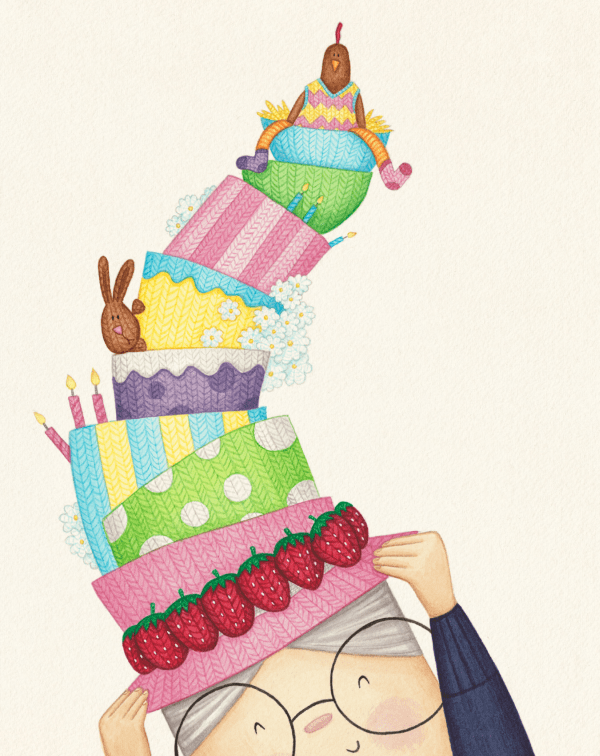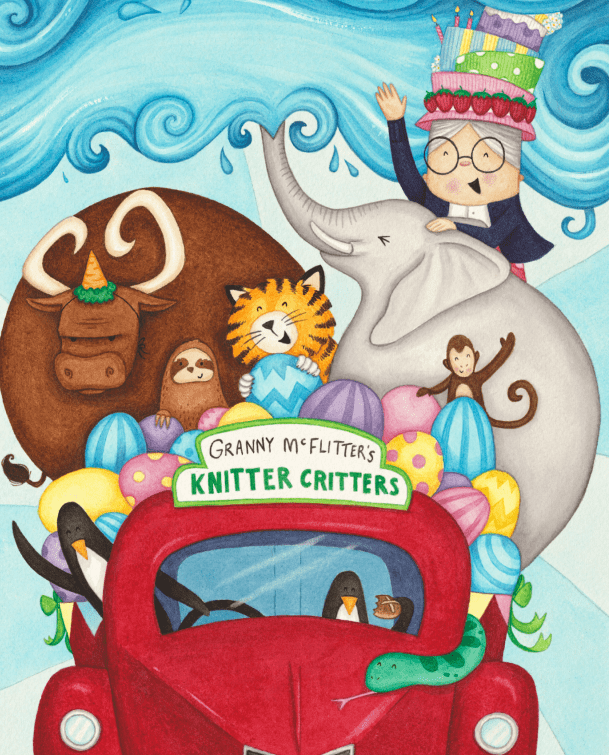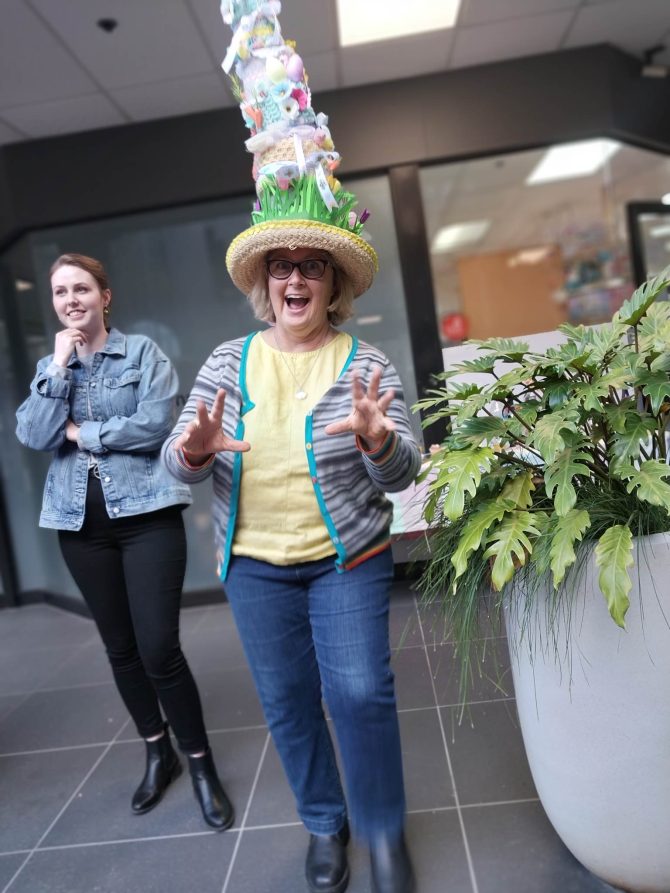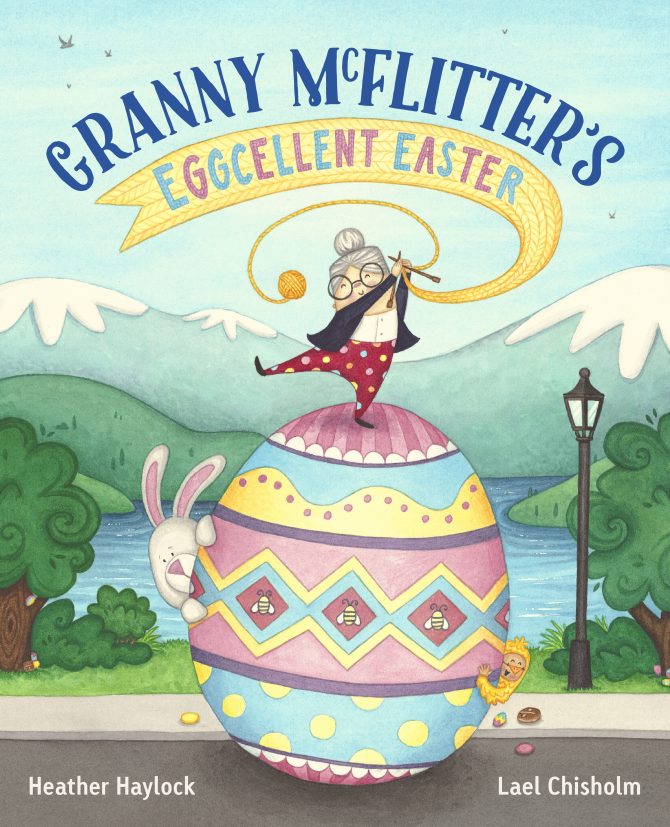The Easter chocolate may be long gone, and this year's egg hunts already nothing but memories, but that doesn't mean you can't enjoy the crazy shenanigans of Granny McFlitter in her latest adventure, !
I've loved this exuberant Granny and her crazy knitted creations since I first found her on the library shelf, so it was a real pleasure to be able to ask Heather Haylock and Lael Chisholm a few questions about Granny, knitting, and how they brought this character to life.
Interview with Heather Haylock
Missbeecrafty: Having grown up with a prolific knitter, I really love the repeated refrain from the Granny McFlitter books: “Did Granny stop knitting, oh no she did not! She kept right on knitting … like it or not!"
So my first question is, are you a prolific knitter like Granny McFlitter?
I didn’t used to be. I knitted a few scarves that looked more like cobwebs when I was a teenager, and muddled through a baby jumper when my daughter was a baby, but I was in no way proficient.
Knitting props for launches and school visits for the Granny McFlitter series has turned me into a knitter. And now it’s one of my favourite past-times.
Granny knits some amazing, and sometimes really strange things! What’s the most unusual thing you’ve ever made?
It’s hard to choose! I’ve made a basket of knitted vegetables. And a stingray. Lots of penguin jumpers, and now Easter eggs too.
What other crafts do you enjoy?
I am a keen quilter. I have several vintage sewing machines that don’t need electricity – they are hand cranks and treadle machines. Great for taking camping, or in a power cut!
Although knitting and writing are quite different, are there ways that you think they’re the same?
Great question! I guess you follow rules for both – patterns for knitting, and things like story arcs for writing. I like that both crafts involve creativity, and that you can break out of a set pattern and have fun too! I also love that, really, knitting is a simple thing made up of two basic types of stitches (knit and purl) that you can do in different ways to make things look complex. And writing is made up of using the 26 letters of the alphabet in different ways to write a story. Sometimes I stare at a dictionary and think how astounding it is that all stories, from the simplest board books, to the most complex intellectual, literary novels, are all made up from words in the dictionary – it’s just all about choosing which ones to use and in what order to use them.
Were your Grannies anything like Granny McFlitter?
I didn’t have the privilege of knowing my grannies. They both died before I was born. My parents, though, had me quite late in life, and my mum was often mistaken for my granny! She was a good knitter, and kept me warm in knitted jumpers and hats for cold Rotorua winters. I was involved with horse sports, and I certainly needed warm knitted things to wear when out and about with horses when there was thick frost coating the ground.
Where do you draw your inspiration from?
From all kinds of places. I like to keep my senses open for stories and textures and tales as I go about my daily life. Some of my stories come from seeds of ideas I have when reading the news, listening to people talk, and when out walking watching animals. I worked with children for 13 years in a primary school, and some of the things they said have given me ideas for years!
 Granny’s Easter bonnet is really something else! Do you have any Easter traditions you’d like to share?
Granny’s Easter bonnet is really something else! Do you have any Easter traditions you’d like to share?
My kids loved a good Easter egg hunt when they were little, and I loved watching them search high and low in the garden. Sometimes I would find the odd egg that hadn’t been found, months later, tucked away under plant pots and shrubs.
I also am a big fan of hot cross buns and what they represent. We try not to eat any till Good Friday, but with them in the supermarkets from February, they’re hard to resist!
Granny McFlitter was your first picture book, but was it the first book you’ve had published?
It’s the first book for me published by a trade publisher. My first thing I could see in a proper bookshop that I’d written, was a short story in the collection called Great Mates, edited by Barbara Else. I felt like I’d won the lottery when she contacted me to say my story, ‘Chemistry on our side’, had been picked for the anthology!
Having Granny McFlitter on the shelves in actual libraries and bookshops has been huge for me – I’ve lost count of the times I’ve just stared at them on the shelves, and well-meaning librarians and shop assistants have asked if I need any help! It’s a magical feeling, seeing words that were dreamt up in my head, turned into actual books that people buy for the children in their lives!
I’ve since also been very happy to have a number of both fiction and non-fiction stories published with Sunshine Books NZ. Some of the fiction stories are actually ‘recycled’ from picture book manuscripts that haven’t been picked up by any trade publishers. I love the idea that some of those stories will probably actually be read by more children over a longer period of time, than my picture books will. Even though the ‘early reader’ texts can look simple, they are often the first real experience children have with discovering the joy of picking up a book, reading and understanding it, and getting lost in an imaginary world, all by themselves. I see that as a huge responsibility as an author – to write high quality stories for beginning readers to discover and begin their journey as life-long readers and lovers of story.
When you wrote the first Granny McFlitter story, you didn’t yet have anyone to illustrate it, right? What was it like seeing Granny come to life through Lael’s illustrations?
It was magical. I tend not to think visually. I think in sounds and textures of words. When I saw the first roughs of Lael’s depiction of Granny, I thought, “Ah, there you are! Of course that’s what you look like!”
When I learned how young Lael was, I just about dropped my cup of tea! She was only eighteen, and straight out of high school when she won the Storylines Gavin Bishop Award which gave her the opportunity to illustrate our first book for Penguin Random House NZ, Granny McFlitter the Champion Knitter. I am loving watching her grow and flourish as an illustrator – I can really see the progression of her talent developing over time. Her pictorial storytelling skills are growing in leaps and bounds.
When did you decide you wanted to be an author?
When I was in Form 1 (year 7), we were asked to write and illustrate a story to take next door to the primary school to read to the New Entrants. My story was called, Flip-Flop to the Rescue, about a frog who could only do backstroke, but that didn’t stop him from rescuing a little frog named Petunia when she fell in the pond. When they grew up, they got married and had twin tadpoles and lived happily ever after. J We bound our booklets with wool, and trooped off next door to the primary school.
I clearly remember, walking back to school having visited the New Entrants, thinking, ‘Wow, those little kids really liked my story. I wonder if that’s something I could do when I grow up – be an author.’
I went to university, trained in geography and social sciences, worked as a resource management planner specialising in natural hazards, and then when my own children were little, I remembered my childhood dream and took a correspondence course on writing for children. I worked as a teacher aide for 13 years at the local primary school my two attended, and honed my writing skills in my spare time.
Oh, and I still have my battered copy of Flip-Flop to the Rescue, bound up with wool - I take it with me to school visits.
What does a day's writing look like for you? Do you have a favourite place to write?
I write all kinds of places. I hope, one day, to have a writing cabin in the back yard to retreat to. But for now, I use a corner of the dining room mostly. If I need peace and quiet, I’ll often go to my local library in Papatoetoe. There is an upstairs study space that is deserted during the day time till students finish school. I go there to write quite a lot, away from the distractions of home and housework.
I also like to write ‘in the wild’. I’ll take a notebook and paper, or sometimes, one of my vintage typewriters, to a park or to the beach and see what happens!
What other tools do you use for your writing? Are you a computer gal, or do you prefer writing old school, with pen and paper, or a typewrite?
I do all of those things! First drafts, always on paper. I’m fussy, so prefer unlined notebooks. And I like pencil rather than pen. But when an idea strikes, I write on whatever is to hand – till receipts, the backs of envelopes, my hand, someone else’s hand . . .
Once I’ve got an idea corralled on paper, I type it into the computer, then print it out to edit. When I’m at the end stages of a story, I can edit straight into the computer, but there’s just something about the scratch of pencil on paper, and the ability to draw lines and arrows, that makes the pencil and paper editing process easier for me.
I do have a collection of vintage typewriters, and will sometimes take them out for a whirl in the wild. It’s interesting that when typing, the thing that seems to come out the most, is poetry. Not rhyming, Granny McFlitter-type poetry, but more lyrical, sometimes quite dark poetry.
I’ve heard that as a child, you liked to read in trees, or while on horseback (though I assume not while galloping!) Where is the most unusual place you’ve read a book?
I’d say reading on a horse is probably the most unusual place I’ve read. In fact, I did most of my swot for School Certificate exams on the back of a horse, too! His name was Filigree. When there wasn’t much grass in his paddock, I’d take him out to graze on the sides of the roads. (It’s called ‘grazing the long acre’.) I’d sit backwards on him with my papers spread out on his rather wide, table-like rump! He was a very patient horse!
Who was your favourite author when you were a kid?
I grew up on a steady diet of Golden Books and Dr Seuss. Some of my favourites then are still my favourites now. Horton Hatches the Egg by Dr Seuss, and The Friendly Book, by Margaret Wise Brown, are two of them. Both of them are in jaunty rhyme, and I know parts of them off by heart. I’m sure they have had a big impact on the type of writing I do now.
What sort of books do you enjoy reading now?
I love historical creative fiction most of all. It’s fun reading about actual historical events through the eyes and experiences of fictional characters. I enjoy reading for pleasure while learning things at the same time. A book I’ve recently re-read in this genre is The Moonlight School, by Suzanne Woods Fisher.
I try to read as many new picture books as I can, too. It’s important to keep up with what’s trending, and to analyse the text to see what works and what doesn’t.
What do you think we might see in Granny’s next adventure?
Who knows, knowing Granny McFlitter?! She never ceases to surprise us with the crazy things she comes up with! Watch this space, for sure!!

Interview with Lael Chisholm
I believe you were 18 or 19 when you won the Storylines Gavin Bishop Award for illustration. I know at that age, I hadn’t decided what I wanted to do “when I grew up”! Had you decided then what you wanted to do when you “grew up”?
Not really! I don't think I ever really thought too much about what I wanted to be when I “grew up.” I’ve always loved to draw but never thought it would be a practical career option as it is not always a stable source of income. I had been working at my local hardware store for a few months when I entered the Storylines Gavin Bishop award and thought that art would always just be a hobby.
What prompted you to enter the competition?
One of my uncles told me about the competition about three weeks before the closing date, and I thought it sounded like a good opportunity to get some experience illustrating someone else’s words and see if I liked it. I actually wasn’t expecting to win the award as I knew that university students often entered, and I had only just finished high school so I had no formal art training. I’m so glad I entered though, because it is what launched my career in illustration!
What was it like being mentored by Gavin Bishop?
Being mentored by Gavin Bishop was awesome. He has so much valuable knowledge from the many successful years he has spent in the children’s publishing world and his mentoring gave me a good solid foundation to build on. I remember after every phone call with Gavin I would write down as many pieces of advice he gave as I could because I didn't want to forget any of his pearls of wisdom! I felt that with Gavin’s encouragement and guidance along with the support from the publishers at Penguin Random House I was introduced to the ins and outs of picture book illustration in a way that made me feel valued and invested in, and I felt safe to ask questions and make mistakes as I learnt.
Did you always want to be an illustrator?
I don’t think so, I just knew that I loved to draw but probably wouldn’t make a career out of it. There was a time when I liked the idea of being a concept artist for animated films, I think I was drawn to the story telling aspect and the variety of styles and ideas different concept artists had in their work. I love the creativity and imagination that goes into designing characters and environments in films.
I think it was during my last 2 years of high school that I realised illustrating picture books was similar to concept art in a way, because you get to design characters and worlds that bring a story to life. When illustrating picture books, I get to design the characters and environment while also having my illustrations in the final book, as opposed to being used only in the conceptual stages of a film. I love that my illustrations are able to work with the words to tell a story, bringing places and characters to life on the pages for others to enjoy!
Is illustrating your “day job” or a side hustle for you? If it’s not your “day job,” what is?
My work is sort of split half and half at the moment, I work at Mitre 10 a couple of days a week and illustrate the rest of the week. I think I would still call illustration my “side hustle” in terms of income, but it is what I invest most of my time in.
I just love Granny with her high kicks and knitting needles in her bun! Where do you draw your inspiration from?
I basically draw my inspiration from anything I see or hear that I like. I like quirky things, whimsical things, things that make me laugh, things that give me a cosy happy feeling. These could be anywhere, in books, in nature, in everyday situations etc.
When I was younger, I remember reading something about creating dynamic characters by using things like the ‘line of action’ method to create movement and life in your drawings. I think I always have that in the back of my mind which is why Granny McFlitter is so energetic, and it just became part of her personality!

Four Granny McFlitter books in, has your approach to illustrating changed from the first book?
My first book was entirely hand drawn and painted, right from the early drafts and storyboard to the final hand painted illustrations. I went through so many black coloured pencils when planning that book! After that, I began drawing my storyboards and rough drafts digitally. This allowed me to draw faster and alter layouts and compositions easily as I figured out the design of each page, and then I would hand paint the final artwork with watercolour paint.
I think I gain more confidence and like to explore a bit more with each book that I illustrate. There are so many ways to show a particular scene in a story and it’s fun to experiment with different layouts, negative space and colour schemes.
What media do you like to use?
My favourite media for illustration is watercolour paint. I don’t know if I use it how people traditionally use watercolour – I am a perfectionist and I don’t let the paint do what it wants! But with every book I illustrate I learn more about the materials I use, and I love the raw, handcrafted feel that paint and paper have.
Who were your favourite authors or illustrators when you were a kid?
I have always liked A.A Milne’s Winnie the Pooh books and Dr Seuss’ books. I don’t know if they were my top favourites as a kid, but they are the ones that I keep going back to even as an adult.
Is there something you’d like to see Granny do in her next adventure? Or something you’d like to illustrate but haven’t had the opportunity to yet?
I like to be surprised by Granny’s antics, whatever she gets up to I'll illustrate! It would be fun to see her in some kind of aircraft story perhaps, I can imagine her in a vintage helmet and aviation goggles. I have yet to illustrate a book that doesn’t involve Grandparents so it would be nice to break the mould and do something different at some point!
Illustrations can tell their own story, with details that aren’t necessarily in the text. Like the lady at the start of the parade who’s hat has blown off, or the cameo appearance of some animals from Granny McFlitter’s earlier adventures. Have you ever thought of writing your own stories?
Yes! I would love to write and illustrate my own stories one day.
Granny McFlitter's Eggcellent Easter written by Heather Haylock and illustrated by Lael Chisholm. Published by Penguin. Available now.





Add a comment to: An interview with the Eggcellent Heather Haylock and Lael Chisholm